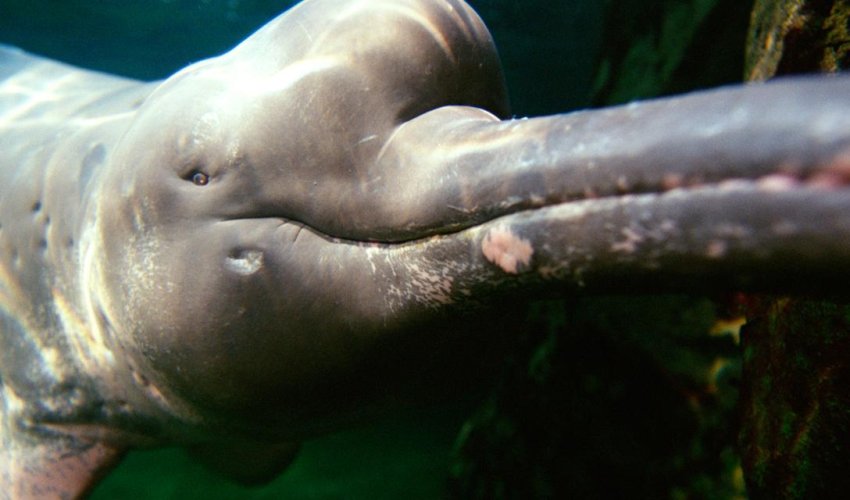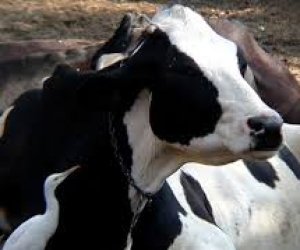Why some species of dolphin has turned pink

Reputation: Botos, or Amazon river dolphins are pink, quiet, solitary, blind mythical mammals.
Reality: They are real, not mythical, but they are the subject of interesting myths. Some are pink. Others are grey. They are anything but quiet. In some regions they are very sociable, and not just amongst themselves. Controversy swirls around how many species there are, and how many of these unusual animals remain.
They stalk the rainforest at night under the guise of exotic and attractive men who seduce – and then impregnate – innocent local women.
Or, at least, so says one popular myth about the Amazon river dolphin (Inia geoffrensis), known locally as the boto. The legend of their nocturnal human transformation "has been used to cover up adultery… and sexual misconduct", says Gabriel Melo Alves dos Santos, a doctoral student at Brazil's Federal University of Para.
The scientific view of the dolphin is a little more mundane, but not without its own mysteries. The truth is that the boto – one of the few remaining freshwater dolphin species on Earth – is still something of an enigma.
We do not know how many there are in the wild or how many species they fall within. We do not even know for sure why this strange dolphin is often a delicate shade of pink.
Not all botos are pink. "Colouration varies," says Vanessa Mintzer, a postdoctoral researcher at the University of Florida, Gainesville. "Typically, younger animals are grey and they get pinker as they age. Usually the adult males are the pinkest."
One recent hypothesis suggests the pinkness develops because botos fight a lot, and it is their scar tissue that is pink. There is certainly a lot of aggression between the dolphins, especially the males, which are about 55% heavier than females.
"Almost the entire body surface of adult males is often covered with multiple overlapping tooth-rake marks," write Anthony Martin at the University of Dundee, and Vera da Silva of the National Research Institute of the Amazon in Brazil.
Mammal colouration expert Tim Caro of the University of California at Davis offers an alternative explanation. "Pink is surely a way to match the particulate red mud that occurs in some of the rivers following heavy rains," he says.
Some individuals, he adds, have grey backs and pink undersides. Such countershading – dark on top and light underneath – is common in dolphins, whales, and porpoises. It is thought to be a way to hide from predators.
Scientists are still arguing about how many species or subspecies of boto there are. Some argue for the existence of a southern species in Bolivia, distinct from botos in more northerly Amazonian reaches.
In 2014, Tomas Hrbek at the Federal University of Amazonas, Manaus and colleagues presented evidence for a third species in Brazil's Araguaia River basin. The Marine Mammal Society is not yet convinced of this proposed new species.
Also an enigma is exactly how many botos there are in the Amazon's rivers. The International Union for Conservation of Nature lists them as "data deficient", but says they may be at risk in some parts of their range.
One challenge to visually counting the numbers of these dolphins is that their riverine waters are often murky with silt.
Botos do not exactly go out of their way to make scientific counts easy, either. Typically, "they just put the tip of their head out of the water", says Alves dos Santos.
Even when seen at the water's surface, they lack the prominent dorsal fin used to photo-identify individuals in other dolphin species. Botos have a subtle ridge on their back, so it is still possible to "fingerprint" individuals using the unique pigmentation patterns, nicks, curves and wounds on its skin. But it is tricky.
Their shy, elusive behaviour and the amount of time they spend underwater means that even the tally of dolphins counted from the same boat – some observers at the front, others at the back – does not always match.Paradoxically, though, some botos go out of their way to make themselves incredibly easy to spot. This can be seen at a market in the town of Mocajuba in Para State, Brazil. There, botos play with local children taking a break from helping their family with sales at the market. The water is clear, and Alves dos Santos has seen the dolphin behaviour in detail.
One of the fascinating things about this behaviour, he says, is the lack of aggression shown by the dolphins. "If they wanted to they could rip those children apart because they are pretty big and they have pretty strong jaws," he says.
But the botos do nothing of the sort. The children stroke and play with the dolphins almost every morning. Locals report that this interaction has been happening for 30 years.
At the market, botos are always in groups, never alone. That is unusual, says Alves dos Santos's research advisor Laura May-Collado at the University of Vermont. "Many scientists have assumed these animals are solitary," she says, the only groups being a mother and young.
Alves dos Santos has discovered that some individuals come to the market repeatedly, year after year. Is that to take advantage of an unusual situation – humans feeding them scraps from the market – or are they in stable groups because they are close relatives? He hopes to find an answer by exploring the dolphins' family tree.
(BBC)
www.ann.az
Latest news 
More news 



































 Photo
Photo 



 Video
Video 

